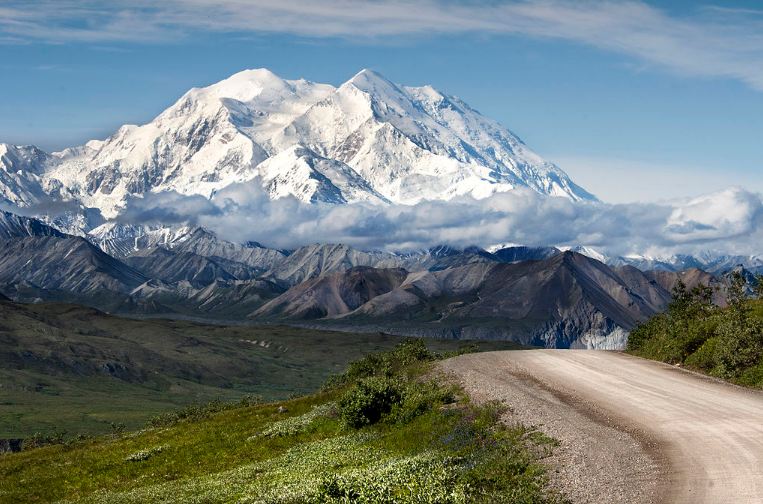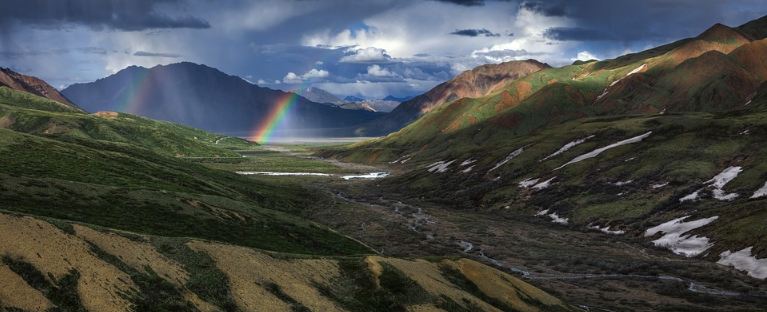The Denali National Park and Reserve is more than just a mountain. It is also a 6-million-acre stretch of wildland, intersected by a single road and home to thousands of flora and fauna. Denali is the continent’s tallest peak at 6,190 meters.
Part of the Alaska Range and found in south-central Alaska, Denali is about 275 km southwest of Fairbanks and 210 km northwest of Anchorage. Two summits rise above the Denali Fault.
The mountain is the centerpiece of the park, but other than this peak are many other astonishing natural sights such as the Polychrome Pass. This is a section of the mountain, much like a road that has been created from a combination of sedimentary deposits and ash. Around 16% of this park is actually made of a glacier, and there are areas in this park that have not been set foot upon by humans; thus, it has been reshaped continuously by various weather conditions.
Throughout history, the Denali National Park has been the location of many major tectonic shifts and a witness to many plants and animals’ growth and evolution. It has been there even from the Ice Age to the Tropical periods. Dinosaurs once inhabited the area, and their fossilized footprints are marked on its soils. Even today, the Denali Mountain is growing approximately a millimeter a year because the plates involved are still shifting.
It has been found that humans have inhabited Denali for almost more than 11,000 years. For the last 500 years, Denali was home to the Tanana, Dena’ina, and Koyukon people. These different cultures called Denali differently. The KoyukonAthabaskans were the ones who called this towering figure “Dinale,” which translates to “Tall One.” Denali was once called Mount McKinley and was changed to its current name on the park’s centennial. This naming of this area has actually been a controversy.
The Denali National Park and Reserve offer day tours & excursions and winter excursions. They have several attractions that travelers venture for, such as parks, trails, hiking spots, and wildlife viewing areas.
During the winter season, from around September to May, Denali is blanketed by snow, and to take a view of the area’s breathtaking landscapes, there are many options. The Aurora Winter Train, the Denali Winter & Spring Drive Adventure, and the Traverse Alaska Winter Adventures give visitors this opportunity.
In Denali, visitors get a glimpse of its wildlife, from animals like Bears, Moose, Wolves, Caribous, Dall sheep, Marmots, Collared Pikas, Red Foxes, Arctic Ground Squirrels, Snowshoe Hares, and numerous bird species. The Tattler Creek is a must for birdwatchers as it is named for the Wandering Tattler. The Polychrome Overlook is another spot where travelers can find bears, caribous, and moose, and at the same time, marvel at the vibrant, colorful volcanic rocks, vegetation, streams, and mountains.
Found in Denali National Park and Reserve is the Cabin Nite Dinner Theatre, where the 1900s Gold Rush tale of Alaskans are acted out, with music, dance, and a warm family dinner. Another scene not to miss is the one played by the Denali Dinner Theatre in the McKinley Chalet Resort. It narrates the first ascent of McKinley while serving the audience with savory salmon and ribs.
The Denali Education Center is an organization that provides learning experiences to people by immersing them through educational events and summer programs. The Eielson Visitor Center is a site that gives its visitors a spectacular view of the mountain with a special treat- the view of herds of DallSheep! While on a bus ride traveling through the Denali Park Road, riders can buckle their seatbelts and keep their eyes on the path to see a wild animal or two passing through.
Denali is not a stranger to weird facts as they possess interesting things about itself. In 2019 alone, Denali was met by more than 600,000 visitors. If the weather’s odds are in your favor, Denali can be seen even when the viewer is 200 miles away.
The only naturally residing amphibian in the Denali National Park is the Wood Frog. They have fascinated scientists and enthusiasts alike. It freezes itself into a cryogenic state during the winter, wherein their hearts cease pumping, and their lungs stop working until thawed in the spring.
Some Denali’s park rangers roam about on four legs. These are the Sled Dogs that have assisted the rangers in keeping peace and order. The spectacular Aurora Borealis is a sight that, when carefully planned, can be caught by travelers.
With history imprinted on its soils and home to many creatures on its surface, Denali’s value to nature, animals, plants, the ecosystem, and humans is very significant. Motions to preserve it and keep it from being compromised are being made each day. From here on, it can be concluded that truly, Denali is more than just a mountain.



